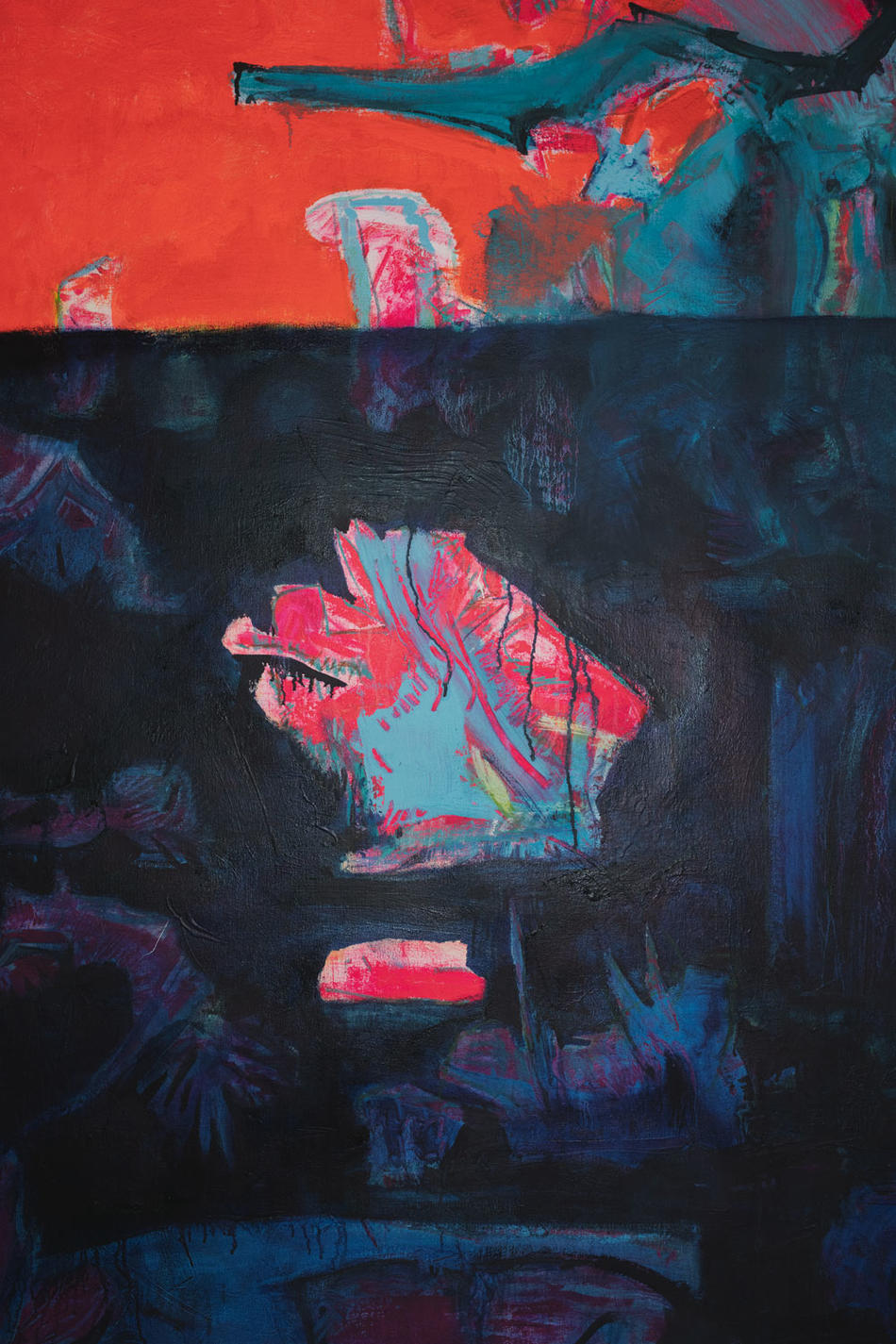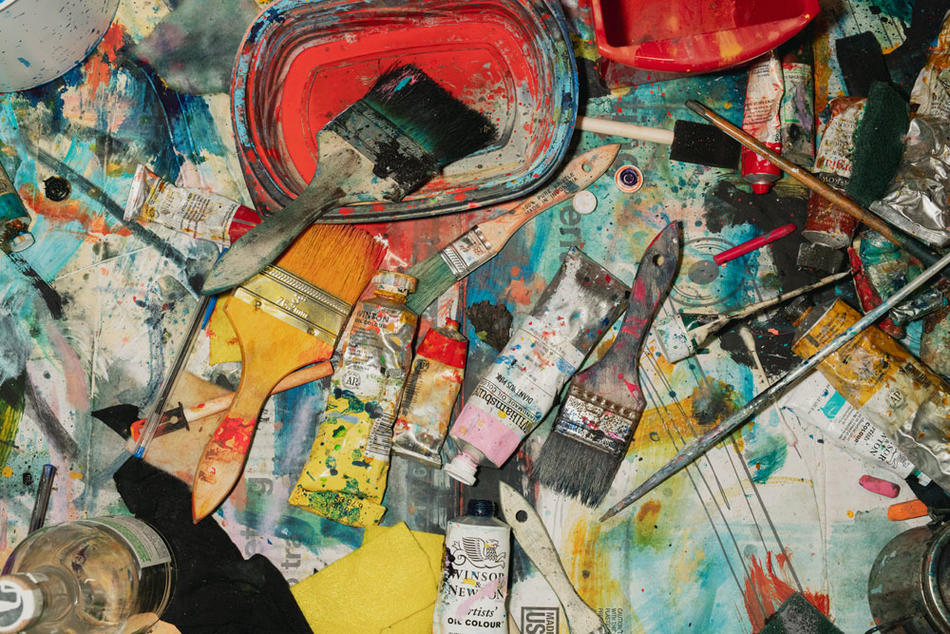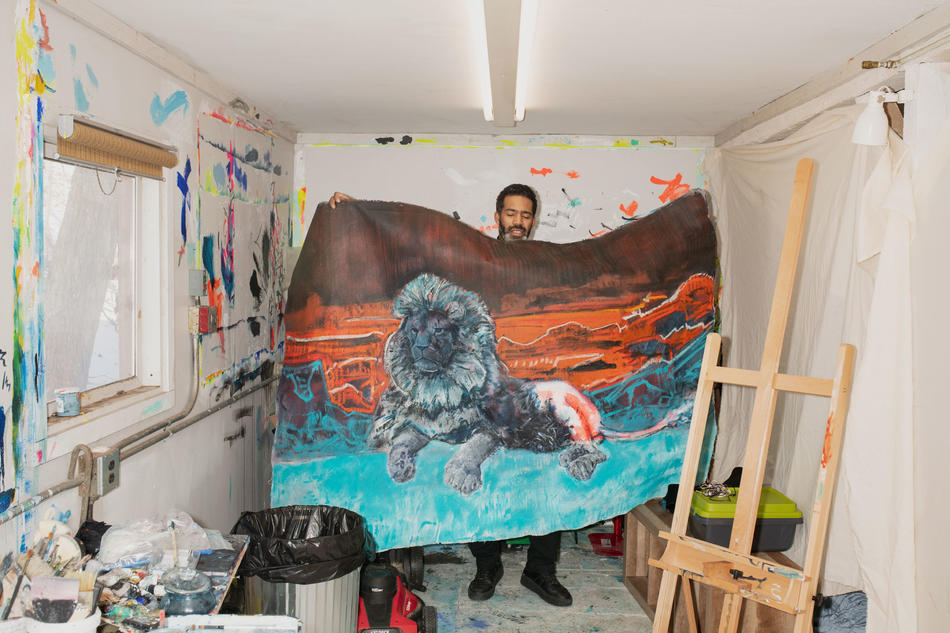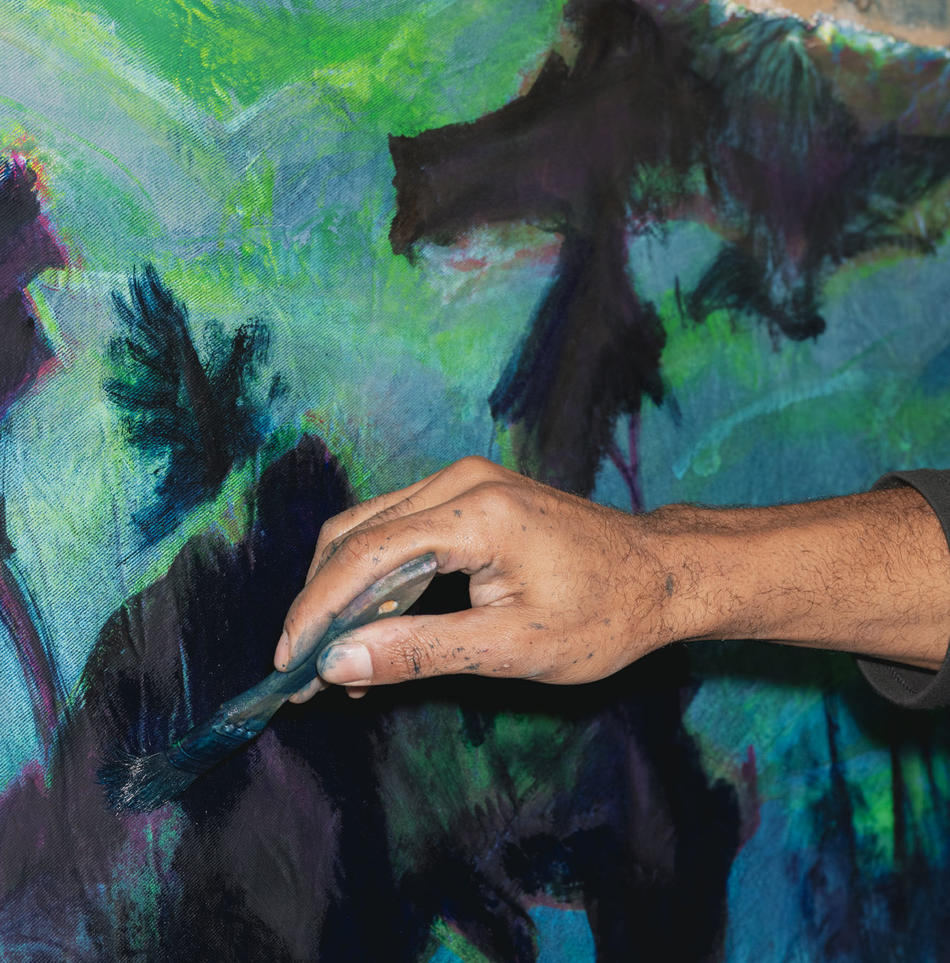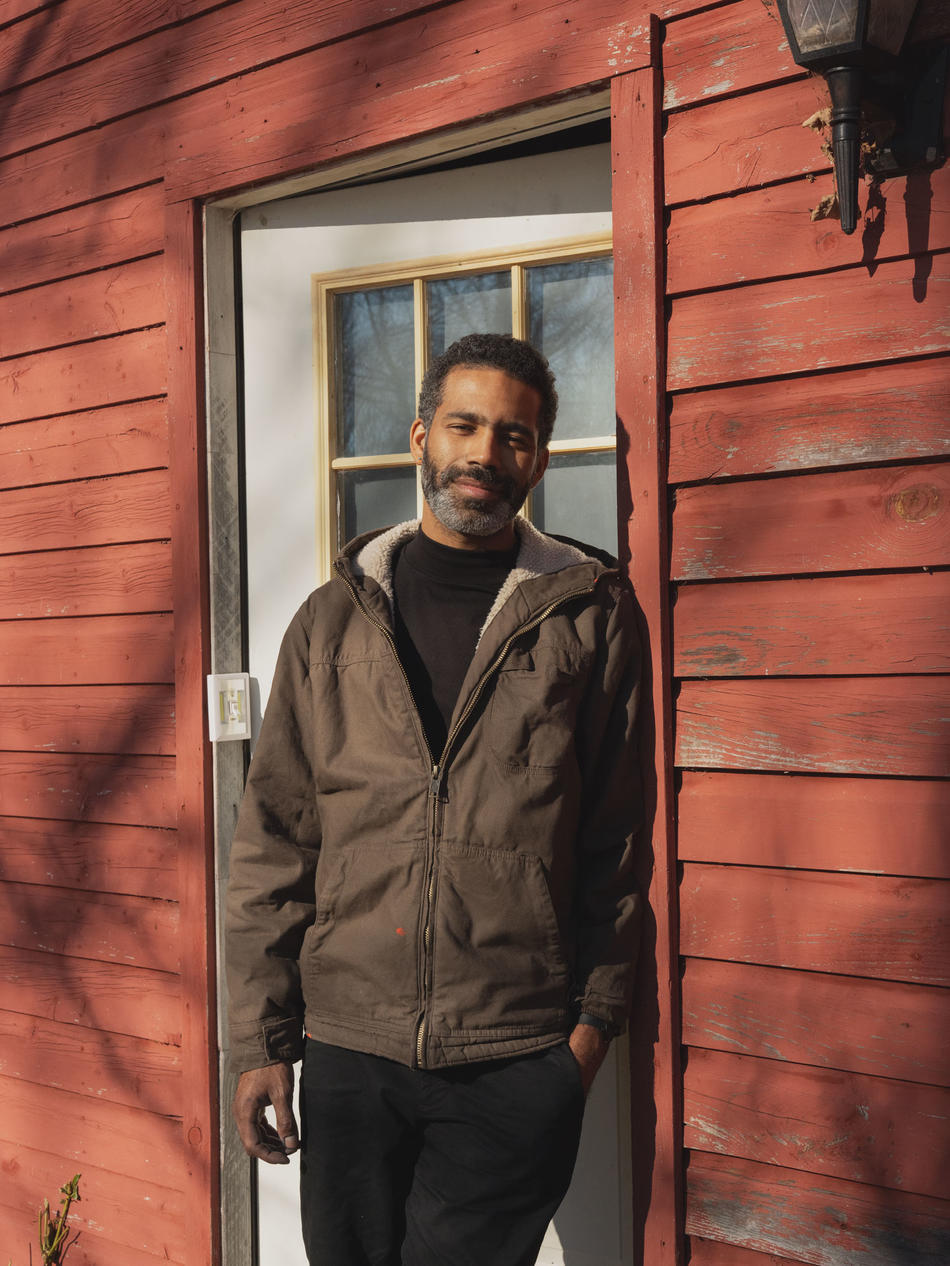Cy Gavin's Luminous Paintings Tell Dark Stories
Tucked away in an old barn off a winding country road in upstate New York, Cy Gavin’s studio is easy to miss. There are no street signs or numbers — just instructions to turn onto a gravel road at the blue dumpster and then to find your way on foot across the grass.
In 2016, when Gavin ’16SOA decided to leave Harlem to live and work in Dutchess County full-time, the two-thousand-square-foot barn was a mess of car parts and old junk. Today, though, it’s cozy and serene. The shelves are lined with books and neat rows of potted plants, an old record player hums in the corner, and a tabby cat tiptoes across the big L-shaped sofa.
Upstairs, where Gavin creates the work for which he’s quickly becoming famous, the room is alive with color. Tubes of paint and coffee cans filled with brushes cover tabletops, stand in precarious pyramids on the floor, and are shoved into the barn’s rafters. Spotlights shine on a huge painting — perhaps six feet by eight feet — propped against one wall. The canvas is ripe with sparkling turquoise and palm-frond green, punctuated by striking patches of deep purple. Across the room, a smaller work, in various shades of orange and red, demands equal attention. On a cold afternoon, with a heavy fog blanketing the windows of the barn, these lush landscapes feel worlds away.
Gavin likes being in nature; he likes the silence of winter and the cheerful birdsong of spring and summer. The barn sits at the edge of 130 acres of wild oak and evergreen forest, and he relishes the solitude. “When I moved here after living in New York, I could practically feel my lungs filling with air again,” he says. “It helps to have a quiet place, especially since the last few years have been really busy.”
Warm and soft-spoken, with a salt-and-pepper-flecked beard, Gavin is clearly a master of both humility and understatement; things have certainly gotten more than a little busy for him recently. In 2015 and 2016, while he was still a student in Columbia’s visual-arts MFA program, Gavin had two sold-out solo shows at the Sargent’s Daughters gallery in Manhattan. In her review of the first show, Martha Schwendener ’89CC of the New York Times compared him to Kara Walker, Kerry James Marshall, and even Gauguin. He spent the summer and fall of 2016 in Miami, as the artist-in-residence at the Rubell Family Collection, with a solo exhibition there following the residency. In 2018, he had another solo show, at Paris’s VNH Gallery, and then exhibited work at Mass MoCA and at the Whitney Museum of American Art. Now, at just thirty-three, Gavin is preparing for his fifth solo show, which opened in March at Gavin Brown’s Enterprise in Harlem.
“So this is kind of the calm before the storm,” he says, gesturing around the wide expanse of the barn’s second floor, taking in the two canvases that are in progress. Gavin says that when he’s preparing for an exhibit, he’s often working on up to six pieces at a time. And though he always has a general idea of what the paintings will be, what stories they’ll tell, he says that he likes to leave room for improvisation.
“I don’t want my work to be predetermined and static,” he says. “I want there to be space for the painting to assert itself.”
Gavin was born and raised in Pennsylvania, in the Rust Belt town of Donora, twenty miles south of Pittsburgh. “It was a ghost town at that point. It had been founded a century ago to support the steel industry, but by the time my family arrived in the 1980s, it was totally economically depressed,” he says. “I actually sort of enjoyed living there, though. There was a stillness in the industrial wasteland.”
Gavin’s parents, who were Jehovah’s Witnesses, worked in a glass factory and moonlighted as missionaries. “It was a fundamentalist, repressive way of life,” Gavin says. His parents’ calling meant that Gavin was on his own a lot of the time. While they traveled around the region “spreading the Lord’s word,” Gavin and his older sister were in the car, sketching or reading, or they were deposited at the Donora Public Library, where they spent long days exploring the stacks.
“We basically spent every day at the library. It turned out to have a profound impact on both of our lives,” he says. Gavin’s sister is now a high-school librarian, working in the Bronx. And Gavin credits the library with introducing him to the visual arts. “There was this series of vintage Horizon magazines and a handful of monographs on the Old Masters, and I’d spend hours sketching, trying to copy the images,” he says. “I think that I liked drawing when I was a kid because it was a skill where I could readily notice marked improvement. When I got better at it, there was evidence.”
Pittsburgh’s famous Carnegie Museum of Art was just a thirty-minute drive from his house, but Gavin says that the thirteen-dollar student entrance fee was more than he could afford. He discovered a way to sneak in through the building next door, which connected to the museum through the basement. “Once I figured out how to get in, I basically never left,” he says. But the fact that he essentially had to break into the museum to access art bothers him.
“It still really irritates me. High admission prices effectively prevent working-class people from being able to visit museums,” he says.
Gavin says that money concerns initially kept him from considering art as a career, or even something to study when he got to college. “There is an inherent privilege in thinking of art as a career,” he says. “Growing up poor meant that making art for a living never felt like an option.” Gavin says that a fluke landed him in Carnegie Mellon’s prestigious undergraduate art program. He had planned to go into science, but thanks to an art teacher who took a special interest in him, Gavin ended up attending an event with admissions officers from several college art programs.
“There were all these kids coming from magnet high schools with professional portfolios and slides. I had a garbage bag full of canvases and sketchbooks,” Gavin says. “But so much of their work looked the same. It was technically proficient, but not personal or imaginative.”
The representative from Carnegie Mellon immediately connected with Gavin’s work and essentially promised him admission and a generous grant on the spot. “It was a chain of random events that led to the right person. I think I knew even then that it would change my life.”
At Carnegie Mellon, Gavin had a lot of catching up to do. “Everyone else in the program had a baseline knowledge of art history, which I didn’t have. I felt like I was entering the conversation for the first time,” he says. But he also felt an urgent need not to follow the pack, a sensibility that he says has stayed with him throughout his career. Instead of just focusing on art, Gavin also minored in history, becoming immersed for the first time in the study of the American colonies and the Caribbean slave trade, both of which would go on to inform much of his work. And while his classmates seemed more concerned with where they fit in the art-history continuum, Gavin says that he was prone to experimenting. “I felt free to try everything and find my own way. I could discover my own purpose without thinking about what had already been done.”
After graduating in 2007, Gavin spent a few years in San Francisco working in video postproduction before starting to think more seriously about trying to make it as an artist. He moved to New York in 2011 and got a job as a website manager for Participant Inc., a nonprofit alternative art space on the Lower East Side. “I was, and still am, drawn to finding different spaces and contexts for art,” he says. From there, he worked as an assistant to the feminist photographer and filmmaker Ellen Cantor and as an archivist for the video and installation artist Vito Acconci. With their encouragement, he decided to apply to MFA programs.
Gavin says he picked Columbia in part because it was a university rather than a conservatory. “I wanted a program with a lot of freedom, and Columbia offered that,” he says. He supplemented his studio instruction with coursework in history, film, and literature, which turned out to be equally formative to his artistic work, he says. And when he wasn’t in class, he was in the studio, sometimes for twenty-four-hour stretches, just making art.
Gavin relished the freedom that Columbia afforded him and pushed it to its limits; he started storing his paintings in a Columbia-owned building in West Harlem and found an empty space there that he turned into a secret art gallery. “It hadn’t been used in at least twenty years,” he says. “But it had this wonderful natural light. It felt like a crime that it was sitting empty.” Gavin cleared cobwebs, painted the walls, and even installed electricity and air conditioning. He named the gallery The Can and recruited Lia Gangitano, founder of Participant Inc., to curate a show of work by sculptors Michael Blake and Ektor Garcia. Visitors would book a slot on Gavin’s website, and he would meet them at a nearby McDonald’s and walk them through the space.
The website of the magazine ARTnews published a review of the show, praising not just the work but the unusual experience of seeing art in such a raw, unexpected space: “Even if you know what you’re getting into, walking through the building’s subterranean corridors to get to The Can is an adventure. You know you shouldn’t be there, but you’re too intrigued to turn back.”
Unfortunately, the gallery was short-lived, and when an official visiting the building discovered the show, Gavin was served a notice to vacate immediately. “I removed all traces of the exhibition, but for a while, I would quickly re-install it on an ad hoc basis for everyone who had booked an appointment,” he says.
The gallery shutdown notwithstanding, Gavin thrived at Columbia. For the first time in his life, he didn’t feel like he was playing catch-up with a cohort that was more prepared than he was or had more resources than he did. “If you worked hard and honestly, you were noticed by the right people,” he says. For Gavin, those people were faculty members like art historian and curator Kellie Jones (“I’m still working through stacks of materials that she gave me to read”) and sculptor and installation artist Sarah Sze.
“Cy is the kind of student you never forget,” Sze says. “He’s open, generous, and inspired as a person and intense, focused, and completely immersed as an artist.”
Video artist Joan Jonas ’65SOA, who guest-lectured often at Columbia, also had a profound impact on Gavin and his work by encouraging him to travel to Bermuda for the first time and reckon with the legacy of his father. Though Gavin’s father was born and raised on the islands, he had immigrated to the United States as a young man and had only been back to his native country once in Gavin’s lifetime. “It’s this tragedy of being born poor in a place that is, essentially, a luxury playground,” Gavin says. “Even if my father had wanted to go back, or bring his family to visit, staying in a hotel there would have been out of reach.”
Gavin’s father died in 2009; it was a complicated relationship, and in the years that followed, Gavin found himself obsessing over the man and the place that made him. “I was sanitizing my memories of him. He was becoming less of a person and more of a myth. That was compounded by the fact that Bermuda was, at that point, a totally imagined place for me.”
Jonas suggested that Gavin bring camping gear and sleep on the beach, an idea that allowed him both to skirt the islands’ high hotel prices and also to connect with the land in a deeper way. The trip was initially meant to be a personal one; Gavin hadn’t intended to make art about Bermuda. But he was intoxicated by the islands’ natural beauty and complex history.
Bermuda, Gavin explains, is unique even to its region, in that it has no indigenous population and almost no native agriculture, so it relied heavily on the slave trade to import both goods and workers. Gavin found that history to be almost erased from present-day society on the islands. “There’s an odd culture of denial about Bermuda’s role in the slave trade and the residual impact socially there. It’s both omnipresent and not mentioned at all.”
On the last day of Gavin’s trip, he found himself having drinks with a friend — a Black woman who had grown up in Bermuda and was now working as a professional golfer. “She made a comment about having to compete on top of her grandparents’ graves, and I realized that she wasn’t speaking figuratively,” Gavin says. Bermuda was one of the earliest island destinations in the Atlantic or Caribbean to attract American tourists, and to accommodate and appease the mass of visitors in the early twentieth century, the governor formed a commission to essentially hide the archipelago’s Black residents in two remote communities. “The government seized all of their land using eminent domain, and in two years they had removed all trace of the community except for a cemetery,” he says. Though the cemetery had historic-preservation status, Gavin says, it was largely destroyed in 2012 by the owners of a luxury resort.
Gavin knew then that he needed to learn more to understand his family’s history and the history of Black people in Bermuda, and that he needed to make art about it. Over the next several years, he took several trips back to the islands, where he would camp and study the rocks, the wildlife, the plants. He brought back natural materials — pink sand, blue irises, agave flowers — and incorporated them into his work, mixing them directly into the paint along with more macabre materials, like his own blood and his father’s ashes. He studied traditional Bermudian dance and used the movements to influence how he drew and placed the figures on his canvases.
Gavin also set out to learn and tell the stories of little-known figures of resistance in Bermuda. He slept in a limestone grotto where a runaway slave named Jeffrey had once sought refuge, an incident that inspired his painting Jeffrey’s Cave. In another piece, Sally Bassett, Laughing, Gavin immortalized the titular Bermudian slave, who was burned at the stake for poisoning her owners. In accordance with a legend that the Bermudian iris sprouted from Sally Bassett’s ashes as a sign of her innocence, Gavin mixed seeds of that plant with his paint.
After graduating from Columbia, Gavin moved to Miami for a six-month fellowship with the Rubell Foundation. There he continued to immerse himself in Afro-Bermudian history. He painted Gibbet Island, a now-private island in Bermuda where slaves were once executed publicly; and he painted a portrait of his great-grandfather Lewis Smith, who had lived in a thriving Black community that was razed to make room for a luxury resort. The works that he created for the VNH Gallery in Paris dealt with similar subjects, though he also found himself gravitating toward the natural elements of the islands for that show — an abstract sunset, a manchineel tree, an underwater reef.
Having settled into his barn upstate, Gavin finds himself ready to explore new themes. “I think I’ll always make work about Bermuda; it’s a part of me, in many ways,” he says. “But I was using it as a lens to look at bigger structures. Now I’m widening that lens.” Gavin says that since the 2016 election, the deep racial and class divides in America have been weighing heavily on his mind, and he expects that much of his work for his upcoming show will be informed by those issues.
Gavin has also been seeking new inspiration from the landscapes of the Hudson Valley. For a recent show at Mass MoCA, he created a nearly twelve-foot-tall rendering of Bash Bish Falls, a waterfall near his home.
“It was considered a sacred spot to the Native American population here,” Gavin says. “Also, it’s incredibly beautiful at night. The moonlight is so bright when it reflects off the falls that you can read a book by it.”
But the beauty, he says, is beside the point. “People have told me before that they think my paintings are beautiful. And I only care about that insofar as I think it helps people spend more time with the work,” he says.
“Susanna Coffey, a painter and mentor from Columbia, once told me that when people see something they perceive as beautiful, it becomes difficult for them to unsee it,” he continues. “I want people to linger on my work, to have their own experiences with it, even when it deals with things that are challenging and unsavory.”
This article appears in the Spring 2019 print edition of Columbia Magazine with the title "A Terrible Beauty."
